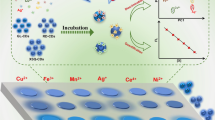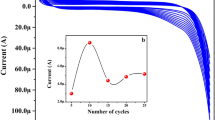Abstract
Aqueous solutions of carbon dots (C-dots) were prepared by microwave-assisted thermal carbonization of poly(ethylene glycol). They were investigated by transmission electron microscopy, absorption and fluorescence spectra. It is shown that diperiodato-nicklate(IV), a strong oxidant, induces the chemiluminescence (CL) of C-dots in strongly alkaline solution without use of an additional reagent. A mechanism for this reaction is suggested. It is also found that the CL of the system is quenched by paracetamol, L-cysteine and glutathione. Under the optimized conditions, the calibration plot is linear with a correlation coefficient (r) of >0.995. The limits of detection are 90, 8, and 60 µg L-1 for paracetamol, L-cysteine, and glutathione, respectively. Spiked urine and serum samples were analyzed and gave recoveries in the range from 84.38 to 116.0 %, with an RSD of 1.2–2.7 %.

Use of diperiodato-nickelate(IV) induces the chemiluminescence of carbon dots in alkaline solution without use of an additional reagent. And using inhibitory effect of the target analyte on the CL achieved the determination of paracetamol, L-cysteine and glutathione.




Similar content being viewed by others
References
Chen H, Lin L, Li H, Lin JM (2014) Quantum dots-enhanced chemiluminescence: Mechanism and application, Coord Chem Rev 263–264: 86–100
Li C, Wu X, Zhang C, Wang A, Ma Y, Zhou M (2014) CdTe quantum dots enhanced luminol-KIO4 chemiluminescence system for the determination of acetaminophen by flow injection analysis. Chin Anal Lab 33:129–132
Xu Q, Wei HP, Hu XY (2013) Glutathione detection based on ZnS quantum-dot-based off-on fluorescent probe. Chin J Anal Chem 41:1102–1106
Baker SN, Baker GA (2010) Luminescent carbon nanodots: emergent nanolights. Angew Chem Int Ed 49:6726–6744
Yan F, Zhou Y, Wang M, Dai L, Zhou X, Chen L (2014) Synthesis and application of the fluorescent carbon cods. Prog Chem 26:61–74
Yang Z, Li Z, Xu M, Ma Y, Zhang J, Su Y, Gao F, Wei H, Zhang L (2013) Controllable synthesis of fluorescent carbon dots and their detection application as nanoprobes. Micro Nano Lett 5(4):247–259
Wang X, Qu K, Xu B, Ren J, Qu X (2011) Microwave assisted one-step green synthesis of cell-permesble multicolor photoluminescent carbon dots without surface passivation reagents. J Mater Chem 21:2445–2450
Wang Q, Liu X, Zhang L, Lv Y (2012) Microwave-assisted synthesis of carbon nanodots through an eggshell membrane and their fluorescent application. Analyst 137:5392–5397
Jaiswal A, Ghosh SS, Chattopadhyay A (2012) One step synthesis of C-dots by microwave mediated caramelization of poly(ethylene glycol). Chem Commun 48:407–409
Chandra S, Pathan SH, Mitra S, Modha BH, Goswami A, Pramanik P (2012) Tuning of photoluminescence on different surface functionalized carbon quantum dots. RSC Adv 2:3602–3206
Lin LP, Wang XX, Lin SQ, Zhang LH, Lin CQ, Li ZM, Liu JM (2012) Research on the spectral properties of luminescent carbon dots. Spectrochim Acta Part A 95:555–561
Yang ZC, Wang M, Yong AM, Wong SY, Zhang XH, Tan H, Chang AY, Li X, Wang J (2011) Intrinsically fluorescent carbon dots with tunable emission derived from hydrothermal treatment of glucose in the presence of monopotassium phosphate. Chem Commun 47:11615–11617
Li LL, Ji J, Fei R, Wang CZ, Lu Q, Zhang JR, Jiang LP, Zhu JJ (2012) A facile microwave avenue to electrochemiluminescent two-color graphene quantum dots. Adv Funct Mater 22:2971–2979
Zheng LY, Chi YW, Dong YQ, Lin JP, Wang BB (2009) Electrochemiluminescence of water-soluble carbon nanocrystals released electrochemically from graphite. J Am Chem Soc 131:4564–4565
Zhou JG, Booker C, Li RY, Sun XL, Sham TK, Ding ZF (2010) Electrochemistry and electrochemiluminescence study of blue luminescent carbon nanocrystals. Chem Phys Lett 493:296–298
Zhou Y, Xing G, Chen H, Ogawa N, Lin JM (2012) Carbon nanodots sensitized chemiluminescence on peroxomonosulfate–sulfite– hydrochloric acid system and its analytical applications. Talanta 99:471–477
Amjadi M, Manzoori JL, Hallaj T, Sorouraddin MH (2014) Strong enhancement of the chemiluminescence of the cerium(IV)-thiosulfate reaction by carbon dots, and its application to the sensitive determination of dopamine. Microchim Acta 181:671–677
Lin Z, Xue W, Chen H, Lin J (2012) Classical oxidant induced chemiluminescence of fluorescent carbon dots. Chem Commun 48:1051–1053
Lin Z, Xue W, Chen H, Lin J (2011) Peroxynitrous-acid-induced chemiluminescence of fluorescent carbon dots for nitrite sensing. Anal Chem 83:8245–8251
Xue W, Lin Z, Chen H, Lu C, Lin JM (2011) Enhancement of ultraweak chemiluminescence from reaction of hydrogen peroxide and bisulfite by water-soluble carbon nanodots. J Phys Chem C 115:21707–21714
Jiang J, He Y, Li S, Cui H (2012) Amino acids as the source for producing carbon nanodots: microwave assisted one-step synthesis, intrinsic photoluminescence property and intense chemiluminescence enhancement. Chem Commun 48:9634–9636
Amjadi M, Manzoori JL, Hallaj T, Sorouraddin MH (2014) Direct chemiluminescence of carbon dots induced by potassium ferricyanide and its analytical application. Spectrochim Acta A 122:715–720
Teng P, Xie J, Long Y, Huang X (2014) Chemiluminescence behavior of the carbon dots and the reduced state carbon dots. J Lumin 146:464–469
Blaikungeri A, Pelletier M, Monnier D (1977) Contribution to the study of the complexes bis(dihydrogen tellurato)cuprate(III) and argentate(III), bis(hydrogen periodato)cuprate(III) and argentate(III). J Inorg Chim Acta 22:7–14
Baker LC, Mukherjee HG, Sarkar SB (1982) Synthesis and characterization of lithium hexaorth periodatonickelate(IV). Indian J Chem 21:618–619
Sun HW, Wang T, Liu XY, Chen PY (2013) A sensitive inhibition chemiluminescence method for the determination of 6-mercaptopurine in tablet and biological fluid using the reaction of luminol–Ag(III) complex in alkaline medium. J Lumin 134:154–159
Shen LM, Zheng LP, Chen ML, Wang JH (2013) The production of pH-sensitive photoluminescent carbon nanoparticles by the carbonization of polyethylenimine and their use for bioimaging. Carbon 55:343–349
Stefanakis D, Philippidis A, Sygellou L, Filippidis G, Ghanotakis D, Anglos D (2014) Synthesis of fluorescent carbon dots by a microwave heating process: structural characterization and cell imaging applications. J Nanoparticle Res 16:2646–2655
Zhao L, Di F, Wang D, Guo L (2013) Chemiluminescence of carbon dots under strong alkaline solutions: a novel insight into carbon dot optical propertiest. Nanoscale 5:2655–2658
Poznyak SK, Talapin DV, Shevchenko EV, Weller H (2004) Quantum dot chemiluminescence. Nano Lett 4:693–698
Fang YM, Sun JJ, Wu AH, Su XL, Chen GN (2009) Catalytic electrogenerated chemiluminescence and nitrate reduction at CdS nanotubes modified glassy carbon electrode. Langmuir 25:555–560
Cui H, Shi MJ, Meng R, Zhou J, Lai CZ, Lin XQ (2004) Effect of pH on inhibition and enhancement of luminol-H2O2-Co2+ chemiluminescence by phenolic compounds and amino acids. Photochem Photobiol 79:233–241
Lau C, Qin X, Liang J, Lu J (2004) Determination of cysteine in a pharmaceutical formulation by flow injection analysis with a chemiluminescence detector. Anal Chim Acta 514:45–49
Wang Y, Zhang Z, Chen XJ, Zhang ZH, An DK (2002) HPLC determination of paracetamol in plasma and bioavailability assessment of paracetamol tablets. Chin J Clin Pharm 11(2):97–99
Yang S, Zhou Y, He H, Yao G, Zhu Z (1999) Pharmacokinetics and relative bioavailability of glutathione tablets. China Pharm 10(1):30–31
Acknowledgments
This work was supported by the Science Foundation Office of Hebei Province (B2014201171).
Author information
Authors and Affiliations
Corresponding author
Electronic supplementary material
Below is the link to the electronic supplementary material.
ESM 1
(PDF 233 kb)
Rights and permissions
About this article
Cite this article
Dong, Y., Su, M., Chen, P. et al. Chemiluminescence of carbon dots induced by diperiodato-nicklate (IV) in alkaline solution and its application to a quenchometric flow-injection assays of paracetamol, L-cysteine and glutathione. Microchim Acta 182, 1071–1077 (2015). https://doi.org/10.1007/s00604-014-1427-y
Received:
Accepted:
Published:
Issue Date:
DOI: https://doi.org/10.1007/s00604-014-1427-y




